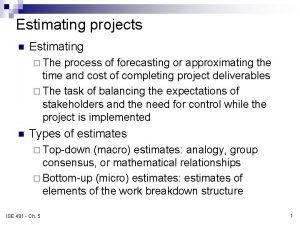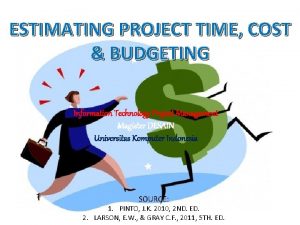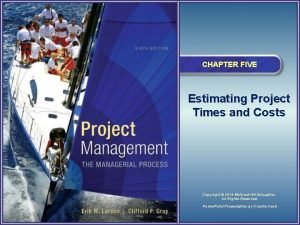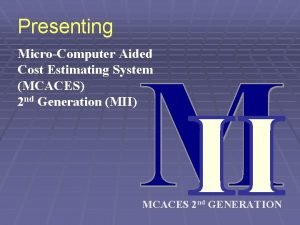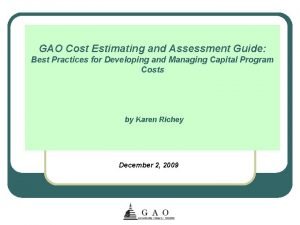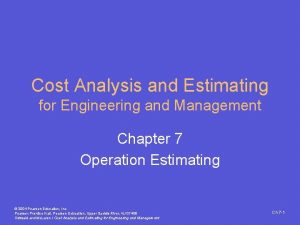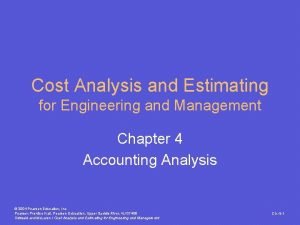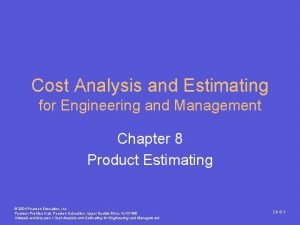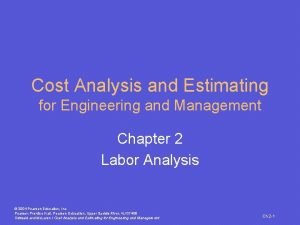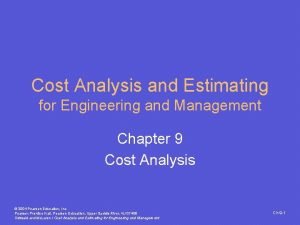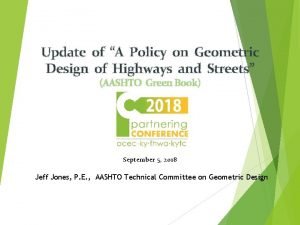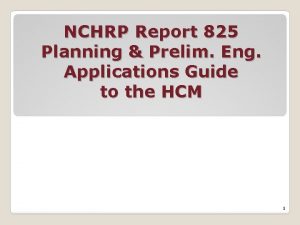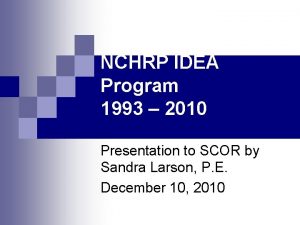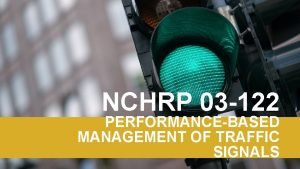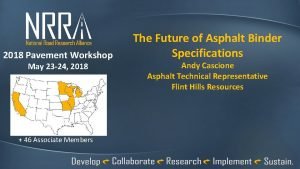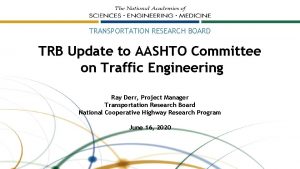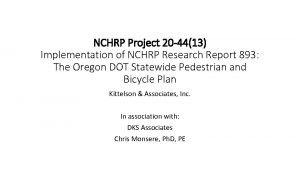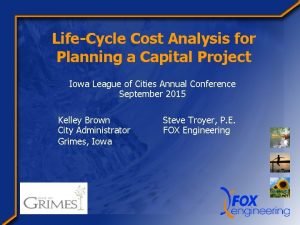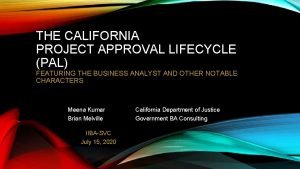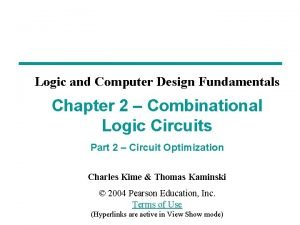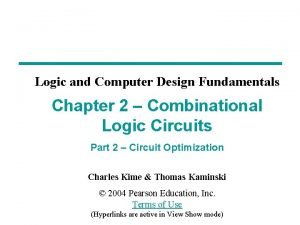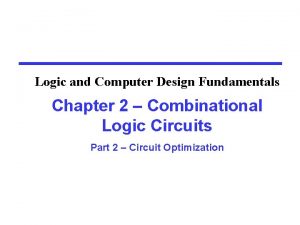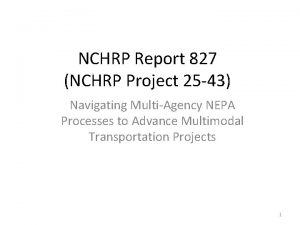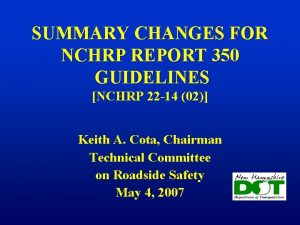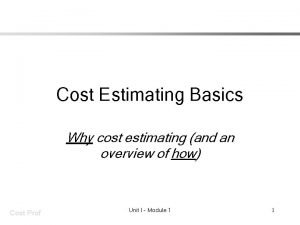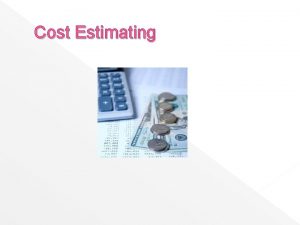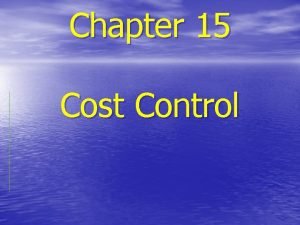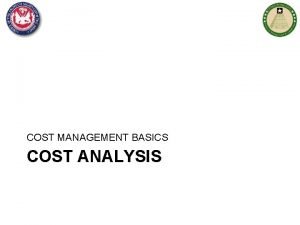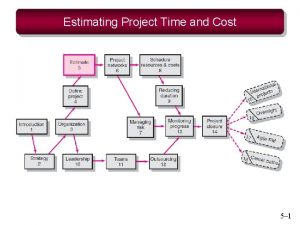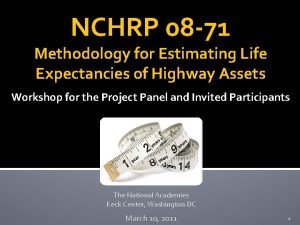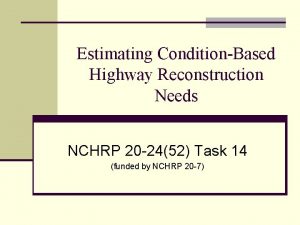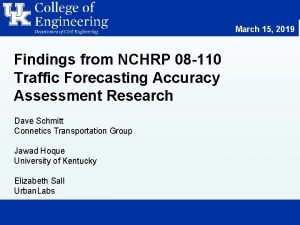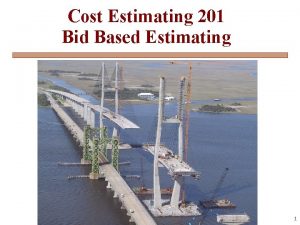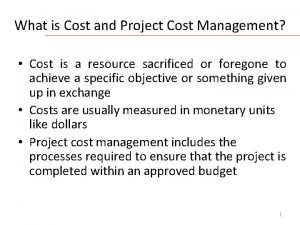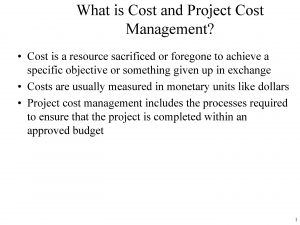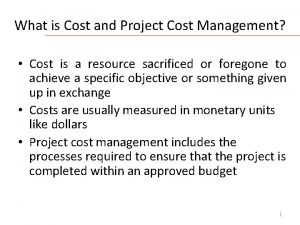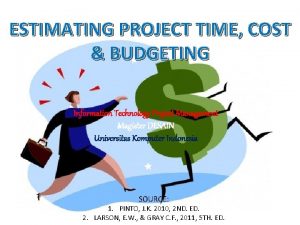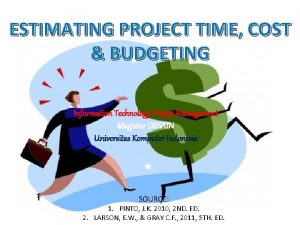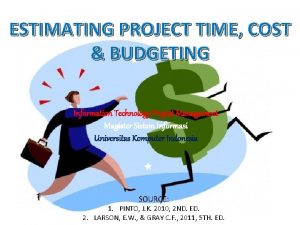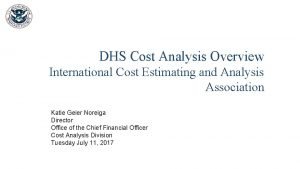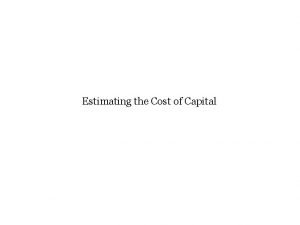NCHRP PROJECT 03 110 ESTIMATING THE LIFECYCLE COST



























































































- Slides: 91

NCHRP PROJECT 03 -110: ESTIMATING THE LIFE-CYCLE COST OF INTERSECTION DESIGNS Kittelson & Associates, Inc.

NCHRP Project 03 -110 Welcome and Introductions Project Objective and Overview Research Approach Life-Cycle Cost Estimating Tool Case Studies Conclusions

Welcome and Introductions Project Team Kittelson & Associates, Inc. Lee Rodegerdts, P. E. , Principal Investigator Team: Wayne Kittelson, David Reinke, Joe Bessman, Matt Kittelson & Julia Knudsen ECONorthwest Carl Batten and Mike Wilkerson Write Rhetoric – Technical Editing Danica Rhoades

Welcome and Introductions 4 NCHRP Staff and Panel Rick Collins – Panel Chair Gilbert Chlewicki Matthew Enders Jason Firman William Lambert John Powell Edward James Smaglik Jin Wang Richard Cunard, TRB Hilary Isebrands, FHWA Ray Derr, NCHRP staff

NCHRP Project 03 -110 Welcome and Introductions Project Objective and Overview Research Approach Life-Cycle Cost Estimating Tool Case Studies Conclusions

NCHRP Project 03 -110: Project Objective Develop a spreadsheet-based tool for comparing life-cycle costs of alternative designs for new and existing intersections Demonstrate the application of the tool to range of options: Stop-controlled Traffic signal Roundabout Innovative designs

NCHRP Project 03 -110: Project Overview Task 1: Methodology Task 2: Identification of Costs Task 3: Data Sources Task 4: Mockup of Interface and Outputs Task 5: Validation Plan Task 6: Interim Report and NCHRP Panel Meeting Task 7: Prepare the Tool Task 8: Case Studies Task 9: Final Report Task 10: Webinar Budget: $300, 000 Schedule: May 2013 – June 2015

NCHRP Project 03 -110 Welcome and Introductions Project Objective and Overview Research Approach Life-Cycle Cost Estimating Tool Case Studies Conclusions

Research Approach Life-Cycle Costs in Practice Addressing Different Lifespans Addressing Varying Spatial Scopes Addressing New Types of Intersections Costs

Life-Cycle Costs in Practice Current intersection evaluation practices vary widely by jurisdiction. Nearly all agencies consider the upfront initial capital improvement costs. Operation and maintenance costs are difficult for agencies to quantify. Some agencies consider the societal costs of crashes in evaluating alternatives, though these costs are typically used as informative values. Overall a desire to better compare life-cycle costs but no clear direction or established procedure.

Research Approach Life-Cycle Costs in Practice Addressing Different Lifespans Addressing Varying Spatial Scopes Addressing New Types of Intersections Costs

Addressing Different Lifespans - Overview Purpose of LCCET is to develop a tool that is applicable to a wide variety of intersection forms and in a wide variety of applications. Planning horizon of most agencies is between 15 and 25 years. Intersections in the urban fringe today may be fully urbanized within the planning horizon. Intersections in built urban environments may be in place 50 years. Intersections may exceed their useful life due to increasing traffic, changing user types, or changes to the transportation network. Components of an intersection may have individual lifespans that vary from the intersection lifespan.

Addressing Different Lifespans - Overview Analyst should be provided guidance to help identify the forecasting information available, and consider the factors that would make the intersection functionally or operationally obsolete. Common analysis life cycle is likely to range between 20 and 40 years. The LCCET treats life cycle as a variable to provide flexibility to adapt to the intersection and analysis context and analysis needs. Considers terminal and salvage values, when analysis period is shorter than the useful intersection life.

Addressing Different Lifespans - Methodology Net Present Value (NPV) = PVBenefits – PVCosts + PVSalvage Value

Research Approach Life-Cycle Costs in Practice Addressing Different Lifespans Addressing Varying Spatial Scopes Addressing New Types of Intersections Costs

Addressing Varying Spatial Scopes Identify the spatial and geometric layout of each alternative. Identify influence limits for each of the concepts. Back of queue Start of deceleration Overlay these influence limits, and establish a cordon line based on the most distant influence limit of the alternatives being considered. Record performance metrics for all vehicles from the time they enter to the time they exit this cordon limit for each of the concepts.

Addressing Varying Spatial Scopes Unsaturated Conditions

Addressing Varying Spatial Scopes Unsaturated Conditions

Addressing Varying Spatial Scopes Unsaturated Conditions

Addressing Varying Spatial Scopes Oversaturated Conditions Cordon line must encompass network area where queuing exists or traffic volume/pattern changes occur. Microsimulation may be required. Separate consideration of Cordon Area and Modeling Area. System and Context Considerations Consider the area beyond the study intersection (e. g. land use, signal coordination, nearby failing intersections, etc. )

Research Approach Life-Cycle Costs in Practice Addressing Different Lifespans Addressing Varying Spatial Scopes Addressing New Types of Intersections Costs

Addressing New Intersection Types Use of the cordon methodology allows the LCCET to address new intersection types Assumes that all significant differences among alternatives are captured within the cordon and can be estimated within the cordon Life-cycle costs for new intersection types may be constrained by available capital and maintenance cost estimates or crash predictions

Research Approach Life-Cycle Costs in Practice Addressing Different Lifespans Addressing Varying Spatial Scopes Addressing New Types of Intersections Costs

Costs Reductions in user and non-user costs are considered to be benefits and go in the numerator of the benefit-cost ratio User Costs Include construction-related user costs (e. g. , delay) Intersection-related user delay costs Reliability of travel time Safety User operating costs Non-User Costs Emissions Non-user delay, public safety, business impacts

Costs Agency costs should be familiar and relatively easy for agencies to estimate Unit costs may vary considerably between regions. We supply defaults based on national averages, but agencies likely may want to override. Guidance is focused on definitions and what to include/exclude

Costs User and non-user costs Agencies likely have less experience and confidence in estimating these costs The LCCET provides default values and guidance for developing locally-appropriate values of time, etc. Our guidance is consistent with FHWA guidance for TIGER grants and TIFIA financing. For many intersections, some categories of user and non-user costs produce trivial differences between alternatives.

NCHRP Project 03 -110 Welcome and Introductions Project Objective and Overview Research Approach Life-Cycle Cost Estimating Tool Case Studies Conclusions

Life-Cycle Cost Estimating Tool Overview Information Worksheets Parameter Worksheets Alternatives LCCET Outputs Appendix Auxiliary Worksheets

LCCET Overview Converts units of various metrics into Net Present Value Provides the user with national average values for various costs while allowing calibration Provides summary in spreadsheet form

LCCET Overview - Worksheets Worksheet name Purpose Introduction and overview to LCCET List of worksheets and their functions Agency information Project information Discount rate for B-C analysis Unit costs: value of time, cost of crashes, etc. GHG. Costs Discounted unit costs of greenhouse gas emissions Demand Parameters Demands and vehicle occupancies for opening year, end year, and any Introduction Organization Information Cost Parameters interim years Master list of all alternatives, with brief descriptions Allows user to add or delete alternatives Base. Case Cost information for base case: i. e. , the reference alternative Alternative_1 … n Cost information for alternatives 1 to n Outputs Tabular and graphical summary of results Auxiliary worksheets Sheets with supplementary information for running the LCCET program Alternatives_Master. List code.

Life-Cycle Cost Estimating Tool Overview Information Worksheets Parameter Worksheets Alternatives LCCET Outputs Appendix Auxiliary Worksheets

Information Worksheets Introduction Worksheet An overall guide to the LCCET A legend to show the color scheme used in the LCCET List of the worksheets in the LCCET Organization Information Worksheet Used for reference purposes only

Life-Cycle Cost Estimating Tool Overview Information Worksheets Parameter Worksheets Alternatives LCCET Outputs Appendix Auxiliary Worksheets

Parameter Worksheets Cost Parameter Worksheet Base year for discounting All costs in the LCCET is discounted to this year. Discount rate The discount rate is the interest rate that is used to discount all costs to present value. varies between 3% and 4%

Parameter Worksheets Cost Parameter Worksheet Value of time The value of time represents the average tradeoff that travelers are willing to make between travel time and costs. Default value is set to the national average Crashes The user may choose among several categories for defining crash costs.

Parameters Worksheets Cost Parameters Worksheet Greenhouse gases These are the unit costs of greenhouse gas emissions in dollars per metric ton of CO 2 equivalent emissions. Greenhouse gas costs are contained in a separate worksheet Criteria pollutant costs The unit costs of criteria pollutants may be provided by the main pollutant types, or the user may also define the categories to be used.

Parameters Worksheets Demand Parameters Worksheet Provides for the input of total intersection traffic demand Demands are broken down by hour of the year to allow calculation of hour-by-hour average travel times (or delays) through the intersection All values can be overridden by the user Worksheet Sections User inputs Demand profiles Hourly demand

Life-Cycle Cost Estimating Tool Overview Information Worksheets Parameter Worksheets Alternatives LCCET Outputs Appendix Auxiliary Worksheets

Alternatives Worksheets Characteristics of the individual alternatives are defined Data for an individual alternative are entered in a worksheet that is specific to that alternative Managed through the Alternatives_Master. List worksheet to add and, if necessary, delete alternatives

Alternatives Worksheets Base Alternative A case against which all other alternatives are referenced. The base case typically represents a “do nothing” case. Overview of Alternative Worksheet User inputs: Inputs provided by the user. Summary NPV by cost type: Summary of the NPV of costs by type. Background calculations: User travel time costs are calculated on an hour-by-hour basis throughout the year.

Alternatives Worksheets

Alternative Worksheets User Inputs Analysis Years Begin planning and construction – The earliest year that planning and/or construction begins for the alternative Opening year – The year the alternative begins operation End year – The horizon year for the analysis of the alternative. Usually this year is equivalent to the end of the lifetime for the alternative.

Alternative Worksheets User Inputs Planning and Construction Costs Operating and Maintenance Costs Salvage Values Demand Travel Time Delay Safety Emissions NPV Results

Life-Cycle Cost Estimating Tool Overview Information Worksheets Parameter Worksheets Alternatives LCCET Outputs Appendix Auxiliary Worksheets

LCCET Outputs Results are displayed in tabular and graphical format Net present value of all costs by category for each alternative Net present value of benefits in relation to the base alternative

LCCET Outputs Net benefits are considered to be reductions in the following types of costs relative to the base case: Travel-time costs Travel-time reliability costs Crash costs Emissions costs

LCCET Outputs Output tables show several summary measures: Net present value of benefits – Total net present value of benefits compared to the base case. Net present value of costs – Total net present value of costs compared to the base case. Present value of net benefits – Net present value of benefits minus the net present value of costs. Benefit-cost ratio – Ratio of net present value of costs to net present value of benefits.

LCCET Outputs The Outputs worksheet also presents a graphical comparison of the net present value of total costs by category in a stacked -bar format.

Life-Cycle Cost Estimating Tool Overview Information Worksheets Parameter Worksheets Alternatives LCCET Outputs Appendix Auxiliary Worksheets

Appendix – Auxiliary Worksheets The LCCET contains several worksheets that are referenced by the Excel macros that set up the calculations. These worksheets are available should users desire to modify the Excel macros in the workbook. In normal use, these should not be modified by the user.

NCHRP Project 03 -110 Welcome and Introductions Project Objective and Overview Research Approach Life-Cycle Cost Estimating Tool Case Studies Conclusions

Case Study Overview

Example Case Study #1 Intersection Alternatives Evaluation Eagle Road/State Street intersection Ada County Highway District (ACHD) Eagle, Idaho Purpose: Develop a prioritized implementation plan identifying a preferred configuration and concept design for the Eagle Road/State Street intersection. Intersection alternatives considered Alternative 0: Base case (existing signalized intersection) Alternative 1: Roundabout (construction of a multilane roundabout) Alternative 2: Enhanced signalized intersection (expansion of the intersection as a signalized intersection)

Example Case Study #1 Alternative 1: Multilane Roundabout Alternative 2: Enhanced signalized intersection

Example Case Study #1 Alternative: Base Case Base Analysis Year Future Analysis Year Base Average Annual Daily Traffic (veh/d) Enhanced Signal 2014 2035 38, 000 Future AM PM Midday Base Annual Trucks Future Transit/Bicycles/Pedestrians AM PM Delay (Base) (s/veh) Midday AM Delay (Future) PM (s/veh) Midday PDO Crashes Base Year Safety Injury Crashes Performance Fatal Crashes PDO Crashes Future Year Safety Injury Crashes Performance Fatal Crashes Planning/Engineering Costs Right-of-Way Costs Construction Costs Net Present Value Benefits/Costs Roundabout 67, 000 Total Entering Volume (Base) (veh/h) Total Entering Volume (Future) (veh/h) 25 27 26 43 93 93 5 2 0 10 4 0 $0 $131, 724, 932 n/a 1, 553 2, 117 2, 164 2, 671 3, 535 3, 484 2% 4% Not considered 5 30 28 11 49 45 7 1 0 11 1 0 $622, 819 $811, 000 $3, 111, 000 $76, 412, 191 13. 03 25 27 26 77 77 72 5 2 0 9 4 0 $687, 714 $474, 554 $3, 438, 572 $131, 099, 984 1. 14

Example Case Study #1 Roundabout alternative results in the least cost. Enhanced signalized intersection alternative results in relatively small savings. An increased likelihood of crashes Modest savings in delay.

Example Case Study #2 57 Intersection Alternatives Review Powell Butte Highway/Neff Road Deschutes County, Oregon Safety concerns Increasing number of crashes at this intersection High priority location in County Need to identify intersection safety improvements

Example Case Study #2 58 Intersection Alternatives Alternative 0: Base case (existing unsignalized intersection) Alternative 1: Roundabout (construction of a single-lane roundabout) Alternative 2: Offset T-intersection (with two-way stop-control)

Example Case Study #2 59 Existing Unsignalized Intersection

Example Case Study #2 60 Alternative 2 – Offset T-Intersection Alternative 1 – Single-Lane Roundabout

Example Case Study #2 61 Determining the Volumes at Offset Intersections

Example Case Study #2 62 Alternative: Base Analysis Year Future Analysis Year Average Annual Base Daily Traffic Future (veh/d) Total Entering AM PM Volume (Base) (veh/h) Midday Total Entering AM PM Volume (Future) (veh/h) Midday Base Annual Trucks Future Transit/Bicycles/Pedestrians AM Delay (Base) PM (s/veh) Midday AM Delay (Future) PM (s/veh) Midday PDO Crashes Base Year Safety Injury Crashes Performance Fatal Crashes PDO Crashes Future Year Safety Injury Crashes Performance Fatal Crashes Planning/Engineering Costs Right-of-Way Costs Construction Costs Net Present Value Benefits/Costs Base Case Two Offset Intersections 2014 2030 6, 470 Roundabout 9, 980 5. 9 4. 4 n/a 12. 4 8. 1 n/a 1. 1 0. 9 0 $0 $0 $0 $3, 526, 429 n/a 511 647 n/a 855 998 n/a 23% n/a 5. 6 4. 2 n/a 7. 0 5. 7 n/a 1. 2 0. 7 0 $504, 000 $363, 000 $2, 015, 000 $5, 680, 677 0. 26 2. 8 3. 5 n/a 5. 8 6. 5 n/a 0. 5 0. 1 0 $474, 000 $139, 000 $1, 896, 000 $3, 667, 749 0. 94

Example Case Study #2 63 Roundabout alternative results in a lower cost than the two offset intersections

Example Case Study #3 64 Intersection Improvement Study Two T-intersections of Scotch Church Road and Meek Road along Jackson School Road Washington County, Oregon Concerns Continued growth in traffic volumes has created constrained traffic operations and increased safety issues.

Example Case Study #3 65 Intersection Alternatives Alternative 0: Base case (existing offset T- intersections) Alternative 1: Roundabout (construction of a single-lane roundabout) Alternative 2: Signalized intersection

Example Case Study #3 66 Existing Unsignalized Intersection

Example Case Study #3 67 Intersection Realignment Lane configurations for alternatives

Example Case Study #3 68 Alternative: Base Analysis Year Future Analysis Year Average Annual Base Daily Traffic Future (veh/d) Total Entering AM PM Volume (Base) Midday (veh/h) Total Entering AM PM Volume (Future) Midday (veh/h) Base Annual Trucks Future Transit/Bicycles/Pedestrians AM Delay (Base) PM (s/veh) Midday AM Delay (Future) PM (s/veh) Midday PDO Crashes Base Safety Injury Performance Crashes Fatal Crashes PDO Crashes Injury Future Safety Crashes Performance Fatal Crashes Planning/Engineering Costs Right-of-Way Costs Construction Costs Net Present Value Benefits/Costs Base Case Roundabout 2013 2035 13, 750 Signal 20, 167 4. 8 3. 3 n/a 143. 2 282. 3 n/a 7. 6 1, 250 1, 500 n/a 2, 000 2, 200 n/a 3% 4% n/a 10. 01 n/a 17. 5 15. 6 n/a 5. 1 15. 0 n/a 27. 2 29. 9 n/a 7. 0 5. 1 1. 1 4. 9 0 7. 6 0 5. 12 0 7. 0 5. 1 1. 1 4. 9 0 0 0 n/a n/a n/a $20, 841, 265 $6, 890, 424 $19, 285, 681 Estimated capital costs not included in analysis

Example Case Study #3 69 Roundabout alternative results in a lower cost in terms of net present value. Primarily due to the safety cost parameter that was used in the comparison

Example Case Study #4 70 Caltrans Office of Safety Proposal SR-123 (San Pablo Avenue)/Bancroft Way intersection Alameda County, California Proposal Identifies the need to install a traffic signal at the SR-123/Bancroft Way intersection Reduce the number and severity of broadside crashes and crashes between motorists and pedestrians.

Example Case Study #4 71 Intersection Alternatives Alternative 0: Base case (existing unsignalized intersection) Alternative 1: Signalized intersection

Example Case Study #4 72 Existing Unsignalized Intersection

Example Case Study #4 73 Alternative: Base Analysis Year Future Analysis Year Base Year Safety Performance Future Year Safety Performance Base Case Signal 2014 2029 PDO Crashes 1. 6 1. 3 Injury Crashes 2. 4 1. 9 Fatal Crashes 0 0 PDO Crashes 1. 6 1. 31 Injury Crashes 2. 4 1. 9 Fatal Crashes 0 0 n/a n/a $6, 569, 325 n/a $70, 000 $550, 000 $4, 762, 229 3. 91 Planning/Engineering Costs Right-of-Way Costs Construction Costs Net Present Value Benefits/Costs

Example Case Study #4 74 Signalized alternative would cost nearly $2 million less than the existing base alternative. Primarily due to the safety cost parameter

Example Case Study #5 75 Conceptual Design and Analysis US 40/MD 213 Maryland State Highway Administration (SHA) Elkton, Maryland Purpose Relieve congestion and improve intersection safety Candidate Safety Improvement Location Substantial number of crashes

Example Case Study #5 76 Intersection Alternatives Alternative 0: Base case (existing offset T- intersections) Alternative 1: Median U-turn intersection

Example Case Study #5 77 Determining the Delay at a Traditional Intersection

Example Case Study #5 78 Determining the Delay at a MUT Intersection

Example Case Study #5 79

Example Case Study #5 80 Comparison of Travel Time Running Time (s) Geometric Delay (s) Control Delay (s) Travel Time (s) Movement PM Volume (vph) Existing Median U-turn Existing Median U-turn EBL 147 34 77 8. 9 21. 9 62 41 105 140 EBT 698 45 45 0. 0 31 23 76 67 EBR 390 34 34 8. 5 115 21 158 63 WBL 114 28 77 8. 9 21. 9 42 60 79 159 WBT 1060 43 43 0. 0 36 43 79 87 WBR 199 28 28 8. 5 6 18 42 54 NBL 338 35 74 8. 9 21. 9 58 43 101 139 NBT 418 20 20 0. 0 245 32 264 52 NBR 48 30 30 8. 5 50 32 89 71 SBL 206 30 59 8. 9 21. 9 50 70 89 150 SBT 382 20 20 0. 0 80 39 99 58 SBR 130 35 35 8. 5 0 42 43 85 35 42 3. 3 5. 8 69 36 107 85 Weighted Average

Example Case Study #5 81 Alternative: Base Analysis Year Future Analysis Year Average Annual Daily Traffic (veh/d) Total Entering Vehicles (Base) (veh/h) Total Entering Vehicles (Future) (veh/h) Base Case Base 2008 2035 40, 045 Future 48, 054 AM PM Midday Base Annual Trucks Future Transit/Bicycles/Pedestrians AM Delay (Base) PM (s/veh) Midday AM Delay (Future) PM (s/veh) Midday PDO Crashes Base Year Safety Injury Crashes Performance Fatal Crashes PDO Crashes Future Year Safety Injury Crashes Performance Fatal Crashes Planning/Engineering Costs Right-of-way Costs Construction Costs Net Present Value Benefits/Costs n/a 107 n/a 131 n/a n/a n/a $5, 560, 511 3, 304 4, 130 n/a 4, 956 n/a 5% 5% n/a Median U-Turn n/a 85 n/a 104 n/a n/a n/a $4, 527, 909 Estimated capital costs not included in analysis

Example Case Study #5 82 Median U-turn intersection alternative would cost nearly $1 million less than the existing base alternative over the life of the intersection. Auto passenger time cost parameter

Example Case Study #6 Hypothetical example Developed to provide an example that considered the following information: Vehicle delay Variation in vehicle delay (reliability) Bicycle delay Pedestrian delay Transit delay Crashes Emissions

Example Case Study #6 Intersection Alternatives Considered: Alternative 0: Base case (existing all-way stop-controlled intersection) Alternative 1: Signalized Intersection Alternative 2: Roundabout Intersection

Example Case Study #6 Base Case Alternative: Base Analysis Year Future Analysis Year Signal Average Annual Daily Traffic (veh/d) Base 2014 2035 11, 268 Future 17, 510 Total Entering Vehicles (Base) (veh/h) AM PM Midday Base Future 868 1, 155 n/a 1, 315 1, 751 n/a 2% 2% Total Entering Vehicles (Future) (veh/h) Annual Trucks Transit: Existing Users = 1, 500 Future Users = 2, 273 Transit/Bicycles/Pedestrians Bicycles: Existing Users = 750 Future Users = 1, 136 Pedestrians: Existing Users = 500 Future Users = 1, 000 Roundabout

Example Case Study #6 Alternative: AM Delay (Base) PM (s/veh) Midday AM Delay (Future) PM (s/veh) Midday PDO Crashes Injury Base Year Safety Crashes Performance Fatal Crashes PDO Crashes Future Year Safety Injury Crashes Performance Fatal Crashes Planning/Engineering Costs Operations & Maintenance Right-of-Way Costs Construction Costs Net Present Value Benefits/Costs Base Case 12. 8 17. 3 n/a 30. 2 75. 6 n/a 12. 0 Signal 11. 1 21. 4 n/a 14. 7 17. 6 n/a 13. 0 Roundabout 10. 1 13. 1 n/a 21. 0 48. 8 n/a 11. 5 4. 0 4. 5 3. 5 0. 0 18. 5 0. 05 19. 0 0. 0 18. 0 5. 5 6. 0 5. 0 0. 05 n/a $49, 245 n/a $25, 046. 797 n/a 0. 1 $125, 000 $71, 464 $200, 000 $610, 000 $34, 645, 237 -8. 20 0. 05 $275, 000 $87, 879 $300, 000 $1, 650, 000 $25, 133, 793 0. 96

Example Case Study #6 Maintaining the existing configuration provides the most benefit Signalized intersection option shows the least benefit Roundabout provides slight benefits in delay and safety

NCHRP Project 03 -110 Welcome and Introductions Project Objective and Overview Research Approach Life-Cycle Cost Estimating Tool Case Studies Conclusions

LCCET Conclusions Converts units of various metrics into Net Present Value Provide the user with national average values for various costs while allowing calibration Uses “cordon” concept Allows maximum flexibility to analyze a range of conditions: Single intersection Complex intersection or interchange Series of intersections Subarea or area Assumes that all significant differences among alternatives are captured within the cordon and can be estimated within the cordon

LCCET Conclusions LCCET Potential Applications Analysis of alternative designs for a single intersection/interchange or set of intersections/interchanges Programming/prioritizing/funding decisions across a large area Alternatives evaluations for corridors and subareas Signal retiming study along corridor Intersection maintenance/replacement/upgrade

NCHRP Project 03 -110 Questions?
 Estimating project time and cost
Estimating project time and cost Estimating project time and cost
Estimating project time and cost Estimating project time and cost
Estimating project time and cost Où se trouve le numéro d'affiliation mutuelle vignette ?
Où se trouve le numéro d'affiliation mutuelle vignette ? 110-000-110 & 111-000-111
110-000-110 & 111-000-111 Mcaces
Mcaces Gao cost estimating and assessment guide
Gao cost estimating and assessment guide Cost analysis and estimating for engineering and management
Cost analysis and estimating for engineering and management Cost analysis and estimating for engineering and management
Cost analysis and estimating for engineering and management Cost analysis and estimating for engineering and management
Cost analysis and estimating for engineering and management Cost analysis and estimating for engineering and management
Cost analysis and estimating for engineering and management Cost analysis and estimating for engineering and management
Cost analysis and estimating for engineering and management Nchrp report 659
Nchrp report 659 Nchrp 825
Nchrp 825 Nchrp idea
Nchrp idea + p u r d u e + c o o r d i n a t i o n + d i a g r a m
+ p u r d u e + c o o r d i n a t i o n + d i a g r a m Nchrp 9-60
Nchrp 9-60 Nchrp 926
Nchrp 926 Nchrp 20-44
Nchrp 20-44 Cost control and cost reduction project report
Cost control and cost reduction project report Cost control and cost reduction project report
Cost control and cost reduction project report Lcca life cycle cost analysis
Lcca life cycle cost analysis Cdt pal process
Cdt pal process Student life cycle model
Student life cycle model Extended project lifecycle
Extended project lifecycle Extended project lifecycle
Extended project lifecycle Cost accumulation and cost assignment
Cost accumulation and cost assignment Cost accumulation and cost assignment
Cost accumulation and cost assignment Manufacturing cost vs non manufacturing cost
Manufacturing cost vs non manufacturing cost Job order costing vs process costing
Job order costing vs process costing Flotation cost in cost of equity
Flotation cost in cost of equity Non controllable cost
Non controllable cost Cost accumulation and cost assignment
Cost accumulation and cost assignment Manufacturing cost vs non manufacturing cost
Manufacturing cost vs non manufacturing cost Mpv accounting
Mpv accounting Opportunity cost of equity capital
Opportunity cost of equity capital What is a period cost on the income statement
What is a period cost on the income statement Dennis geyer
Dennis geyer Meaning of standard costing in cost accounting
Meaning of standard costing in cost accounting Literal cost gate input cost
Literal cost gate input cost Distinguish between average cost and marginal cost
Distinguish between average cost and marginal cost Cost control and cost reduction difference
Cost control and cost reduction difference Job order cost system vs process cost system
Job order cost system vs process cost system Ordering cost and carrying cost
Ordering cost and carrying cost Literal cost gate input cost
Literal cost gate input cost Literal cost gate input cost
Literal cost gate input cost Trade offs and opportunity cost
Trade offs and opportunity cost The relative proportion of variable fixed or mixed
The relative proportion of variable fixed or mixed Hát kết hợp bộ gõ cơ thể
Hát kết hợp bộ gõ cơ thể Lp html
Lp html Bổ thể
Bổ thể Tỉ lệ cơ thể trẻ em
Tỉ lệ cơ thể trẻ em Chó sói
Chó sói Tư thế worm breton
Tư thế worm breton Hát lên người ơi
Hát lên người ơi Môn thể thao bắt đầu bằng chữ đua
Môn thể thao bắt đầu bằng chữ đua Thế nào là hệ số cao nhất
Thế nào là hệ số cao nhất Các châu lục và đại dương trên thế giới
Các châu lục và đại dương trên thế giới Cong thức tính động năng
Cong thức tính động năng Trời xanh đây là của chúng ta thể thơ
Trời xanh đây là của chúng ta thể thơ Mật thư tọa độ 5x5
Mật thư tọa độ 5x5 Phép trừ bù
Phép trừ bù Phản ứng thế ankan
Phản ứng thế ankan Các châu lục và đại dương trên thế giới
Các châu lục và đại dương trên thế giới Thơ thất ngôn tứ tuyệt đường luật
Thơ thất ngôn tứ tuyệt đường luật Quá trình desamine hóa có thể tạo ra
Quá trình desamine hóa có thể tạo ra Một số thể thơ truyền thống
Một số thể thơ truyền thống Cái miệng xinh xinh thế chỉ nói điều hay thôi
Cái miệng xinh xinh thế chỉ nói điều hay thôi Vẽ hình chiếu vuông góc của vật thể sau
Vẽ hình chiếu vuông góc của vật thể sau Biện pháp chống mỏi cơ
Biện pháp chống mỏi cơ đặc điểm cơ thể của người tối cổ
đặc điểm cơ thể của người tối cổ Thế nào là giọng cùng tên
Thế nào là giọng cùng tên Vẽ hình chiếu đứng bằng cạnh của vật thể
Vẽ hình chiếu đứng bằng cạnh của vật thể Tia chieu sa te
Tia chieu sa te Thẻ vin
Thẻ vin đại từ thay thế
đại từ thay thế điện thế nghỉ
điện thế nghỉ Tư thế ngồi viết
Tư thế ngồi viết Diễn thế sinh thái là
Diễn thế sinh thái là Dot
Dot Bảng số nguyên tố
Bảng số nguyên tố Tư thế ngồi viết
Tư thế ngồi viết Lời thề hippocrates
Lời thề hippocrates Thiếu nhi thế giới liên hoan
Thiếu nhi thế giới liên hoan ưu thế lai là gì
ưu thế lai là gì Sự nuôi và dạy con của hươu
Sự nuôi và dạy con của hươu Khi nào hổ mẹ dạy hổ con săn mồi
Khi nào hổ mẹ dạy hổ con săn mồi Hệ hô hấp
Hệ hô hấp Từ ngữ thể hiện lòng nhân hậu
Từ ngữ thể hiện lòng nhân hậu Thế nào là mạng điện lắp đặt kiểu nổi
Thế nào là mạng điện lắp đặt kiểu nổi Types of information systems
Types of information systems Rounding and estimating
Rounding and estimating
